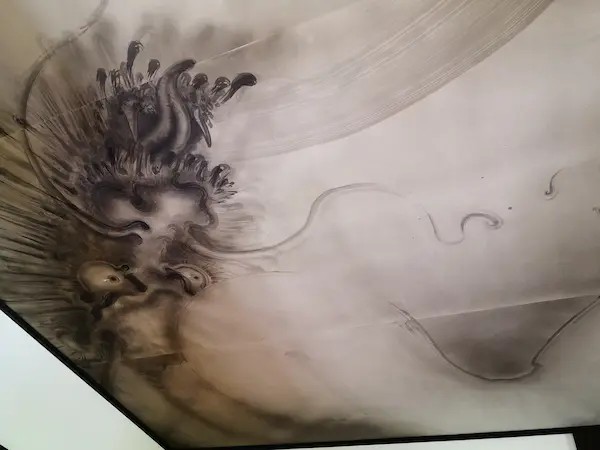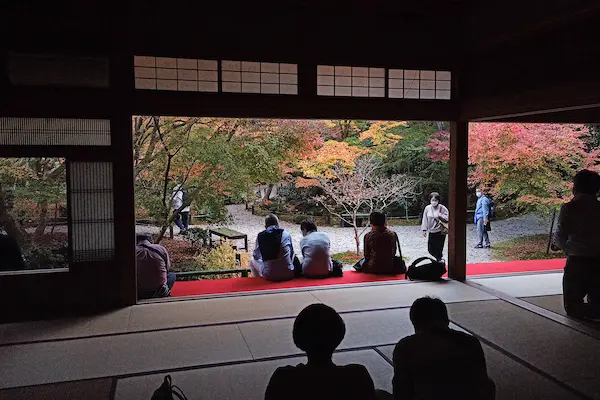Category: Paintings
-

Tenju-an Temple
Tenju-an Temple, a sub-temple of Nanzenji Temple, is a historic Zen temple in the Sakyo Ward of Kyoto City. It belongs to the Rinzai sect’s Nanzen-ji branch. The temple was founded in 1339 during the early Northern and Southern Courts (Nanbokucho) period. It was established by Kokan Shiren, the 15th abbot of Nanzenji, with the…
-

Sennyuji Temple
Nestled in the serene Higashiyama district of Kyoto, Sennyuji Temple, known as “Mitera,” offers a tranquil retreat. Founded in the 9th century, this temple is a significant site for cultural heritage and historical art. This temple is the head temple of Sennyuji Sect of Shingon School of buddhism. Official WEB site Historical Significance Sennyuji has…
-

Daiou-in Temple, Myoshinji (大雄院)
Daiou-in Temple, nestled within the serene grounds of Myoshin-ji Temple in Kyoto, beckons visitors with a rich history dating back to 1603. Founded by Ishikawa Mitsutada in memory of his ill-fated father, the temple unfolds a captivating tale of love and political intrigue. Mitsutada’s mother, Okame-no-Kata, caught the eye of Tokugawa Ieyasu, resulting in the…
-

Houonji Temple (報恩寺)
Nestled in Kyoto’s historic tapestry, Houonji Temple, founded in the Muromachi period, invites foreign tourists on a journey through time and tradition. Originally a confluence of Tendai and Jodo sects, it underwent relocations and reconstructions, surviving the fires of Edo. Discover the famed “Nakiutora” painting, a testament to Toyotomi Hideyoshi’s encounter with a howling tiger,…
-

Kyushoin Temple (久昌院), Kenninji
Kyushoin Temple is one of the sub-temples of Kenninji Temple and is located in the precincts of Kenninji Temple. It is the family temple of the Okudaira clan, founded in 1608 by Nobumasa Okudaira. He was the first lord of the Kano Han. It is said that Kyushoin was named after Nobumasa’s Buddhist name. This…
-

Konchi-in Temple, Nanzenji (金地院)
Nestled within Kyoto’s historic treasures, Konchi-in Temple, a sub-temple of Nanzenji, is a haven of rich history and cultural significance. Established in the early Edo period, it played a pivotal role in Tokugawa Ieyasu’s administration, earning the monk Ishin Suden the moniker “The Prime Minister in Black.” The temple boasts an Important Cultural Property, the…
-

Reikanji Temple (霊鑑寺)
Nestled in Kyoto’s tranquility, Reikanji Temple unveils its splendor to the public for a fleeting two weeks, revealing a hidden gem seldom explored by foreign tourists. Founded in 1654, this Rinzai sect temple holds imperial lineage, its main hall a gift from Tokugawa Ienari. The exquisite Shoin, once an imperial palace, beckons with its tailored…
-

Kyoto National Museum (京都国立博物館)
The Kyoto National Museum was established to collect, house, and exhibit to the public tangible cultural properties as stipulated by the Law for the Protection of Cultural Properties. The museum also conducts related research, surveys, and other projects in order to preserve and utilize these valuable national assets.Source: Museum’s Official WEB site This museum opened…
-

Shougoin Monzeki (聖護院門跡)
The history of Shougoin dates back to 1090. When High Priest Zoyo, who served as a forerunner to Emperor Shirakawa’s visit to Kumano, received the temple. Emperor named it “Shogoin” after his achievement of “protecting the Eucharist”. The temple was later moved from place to place in Kyoto due to warfare and fire, but was…
-

Shusuisha (秀穂舎)
In Shimogamo Miyakawacho (south of Shimogamo Jinja Shrine), there is the Old Asada Family Residence. This is a remnant of “Shake” built in the middle of the Edo period. Currently, the “Shake” building has been maintained and is open to the public as the Kamosha Museum/Shusuisha.” Google map “Shake” refers to the houses of the…
-

Obai-in temple (黄梅院), Daitokuji
Obai-in temple’s gardens are must see if you have chance. This temple is a real hidden gem in Kyoto. Oda Nobunaga built Obai-an in 1562 as a memorial service for his father, Oda Nobuhide. And it is one of the sub-temples of Daitokuji Temple. After Nobunaga’s sudden death due to the Honnouji Incident, Hideyoshi Hashiba…
-

Sumiya (角屋) in Shimabara
Sumiya is an ageya (restaurant/feast facility) that once operated in Kyoto’s Shimabara red-light district (present-day Shimogyo Ward, Kyoto City). Its building has been designated as a national important cultural property. It has been open to the public as the Sumiya Hospitality Culture Museum since 2011. Currently, only the first floor is open to the public.…
-

Wachigaiya (輪違屋)
Wachigaiya is usually closed to the public. Shimabara was the only prestigious red-light district in Kyoto that was officially recognized by the Shogunate. Wachigaiya continues to operate today and is the only tea house/okiya in Japan that has its own Tayu. An okiya is like a production house where maiko and geiko are housed, trained,…
-

Danrinji (檀林寺)
Near the Gioji Temple, you can find another temple with the tablet of “Danrinji Monzeki”. This is a fake temple constructed in 1964. And it borrowed a name from a historical temple. Original Danrinji Temple disappeared in the middle of Heian period (check it on Wikipedia). Current Danrinji is not even a reconstruction of the…
-

Shorenin Monzeki (青蓮院門跡)
Shorenin Monzeki is one of the three monzeki of Enryakuji Temple on Mt. Hiei (other two is Sanzen-in and Myoho-in). It is now one of the five Kyoto Monzeki of the Tendai sect. It originated from Shorenbo, a monk’s abode on Mt. Hiei, which at that time was the residence of Saicho, Ennin, and other…
-

Byodoin Temple (平等院)
Byodoin Temple in Uji represents the beauty of Heian Period. It is a Buddhist temple located in Uji City, south of Kyoto City. It is one of the best preserved national treasures in Japan and a World Heritage Site. (Official WEB site) Byodoin was built in the south of Heian-kyo during the mid-Heian period. The…
-

Shisendo Jozanji (詩仙堂丈山寺)
Shisendo is a branch temple of Eiheiji Temple of the Soto sect of Buddhism, where Ishikawa Jozan lived until his death in 1672 at the age of 90. Ishikawa participated in the Battle of Sekigahara in 1600. And quit the warrior’s life after the Summer Battle of Osaka in 1614. Afterwards, Ishikawa wrote poems on…
-

Reigen-in Temple (霊源院)
Reigen-in is one of the sub-temples located in the southeast of the Kenninji temple grounds. It was founded in the Ouei era (1394-1428) by Ryuzan Tokumi, a monk who was invited to found the temple, and his disciple Ichian Ichirin. Reigen-in Temple was the academic core of Kenninji Temple and produced many of the leading…
-

Kenninji Temple (建仁寺)
When you visit Kenninji Temple, please sit on tatami mat and see the tranquil Choontei Garden. You can simply relax or meditate as time goes by. In 1202, Minamoto no Yoriie, the second shogun of the Kamakura period, donated the temple area and founded the Kenninji Temple. Eisai designed the temple, modeling it after Hyakjōzan…
-

Entoku-in Temple (圓徳院)
Entoku-in Temple is a temple of the Kenninji School of Rinzai Zen Buddhism located in Higashiyama-ku, Kyoto. It is a sub-temple of Kodaiji Temple. It is known as the place where Hideyoshi Toyotomi’s wife, Nene, made her own residence in her later years and is also said to be the place of her demise, according…
-

Manshu-in Temple (曼殊院)
Manshu-in is a monzeki temple located in Ichijodani. From Enkoji Temple, you will pass through a residential area and walk along a path called Manshuin-do (Manshuin Road), which leads to a wooded area. After passing through there, you will see Manshuin Temple. Manshu-in was originally opened by Saicho as a dojo on Mt. Hiei. It…
-

Enkoji Temple (圓光寺)
Enkoji Temple was originally opened by Tokugawa Ieyasu in 1601 as Enko-ji School in Fushimi, and was moved to its current location in Ichijodani in 1667. Cultural assets in the temple include a six-panel screen depicting bamboo groves by Maruyama Okyo (Important Cultural Property) and 50,000 wooden typefaces produced in the early modern period (Important…
-

Tenryuji Temple (天龍寺), Arashiyama
Tenryuji Temple in Arashiyama is one of the World Heritage Sites in Kyoto. It is the head temple of the Tenryuji School of Rinzai Zen Buddhism, founded by Ashikaga Takauji and Soseki Muso. The temple was built to mourn the loss of Emperor Godaigo, who was an enemy of Ashikaga Takauji, so to speak. Before…
-

Chishakuin Temple (智積院)
Chishakuin Temple in Kyoto is the head temple of the Chizan School of Shingon Buddhism. Originally it was in Wakayama Prefecture as one of the sub-temples of the Daidenpoin Temple. Later it was rebuilt in Kyoto in 1598 after a war. Garden Chishakuin Temple has a famous pond garden facing the Daishoin (main drawing room).…
-

Shokokuji Temple (相国寺)
From the Imadegawa Gomon gate on the north side of the Kyoto Imperial Palace, walk north past the Doshisha University campus and you will soon come to Shokokuji Temple. Shokokuji Temple is the head temple of the Shokokuji School of the Rinzai Sect of Zen Buddhism. Temple’s official WEB site The temple was founded by…
-

Kyoto Imperial Palace (京都御所)
The Kyoto Imperial Palace is open to the public all year round. As a rule, the Palace is closed to visitors every Monday, during the year-end and New Year holidays, and when other events are held. Present-day Imperial Palace (Kyoto Gosho) is often thought of as the Daidairi (imperial residence) of Heian-kyo period. But this…
-

Nijo Castle (二条城)
Nijo Castle was built in 1603 by Tokugawa Ieyasu to guard the Kyoto Imperial Palace and provide lodging for shoguns traveling to Kyoto. 1611 saw Toyotomi Hideyori and Tokugawa Ieyasu meeting at Nijo Castle, and the third shogun, Tokugawa Iemitsu, undertook extensive renovations for Emperor Gomizuo’s visit to the castle, including the Ninomaru Palace, which…
-

Kanchi-in Temple (Toji) 観智院
Kanchiin is one of the sub-temples of Toji Temple. It is just inside the Kita-Soumon gate (an important cultural property) of Toji Temple. The path from the Kitasomun is called Kushige-koji, which is said to be the very width of the road in ancient Heiankyo Capital. Kanchi-in is a Shingon school temple. The entrance is…
-

Taizo-in (Myoshinji) Temple 退蔵院
One of the sub-temples near the Myoshinji Butsuden is Taizo-in Temple. This temple is home to the National Treasure “Hyonenzu,” the historic site and place of scenic beauty “Motonobu’s Garden,” a dry landscape garden, and the pond garden “Yokoen,” a garden with a circular garden. Unfortunately, Hyonenzu is not open to the public and you…
-

Seiryoji Temple (清凉寺)
Seiryoji Temple, also known as Saga Shakado in Sagano, is a cultural gem awaiting discovery by foreign tourists. Home to the revered Shakyamuni Buddha statue, a national treasure from India, the temple unveils this sacred artifact during special visits. The temple’s origins trace back to Seikaji, the model for Hikaru Genji’s “Saga no Godo” in…
-

Yogen-in (養源院)
Yogen-in Temple is located near Sanjusangendo and Hojuji Temple. Yogen-in Temple has a blood ceiling and cedar door and sliding door paintings by Sotatsu Tawaraya that are a must-see. Unfortunately, you cannot take photos inside the temple. The following is a summarized quote from the history of the temple. Temple’s official WEB site Yododono, the…
-

Sekihoji Temple (石峰寺) Temple associated with Ito Jakuchu
Sekihoji Temple is a temple of the Őbaku school of Zen Buddhism. The temple has distinctive Chinese-style gates, which is a characteristic of Obaku School. It is the place where Ito Jakuchu built a hamplet and spent the last years of his life. You can find his cemetery in the temple ground (there is his…
-

Myoshinji Temple (妙心寺)
Myoshinji Temple is a renowned Zen Buddhist temple located in the northwest part of Kyoto. It is the largest temple complex in the city of Kyoto and serves as the headquarters of the Myoshinji school of the Rinzai sect of Zen Buddhism. Founded in 1337 during the Kamakura period, Myoshinji Temple has a long and…